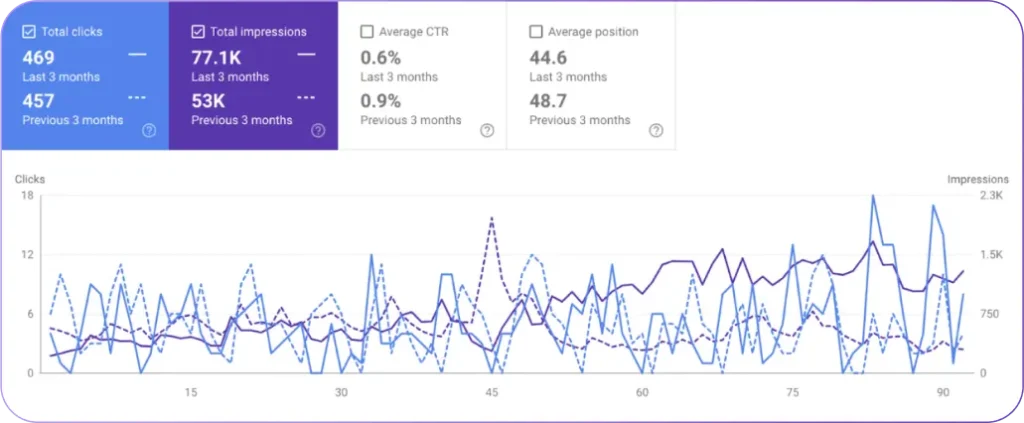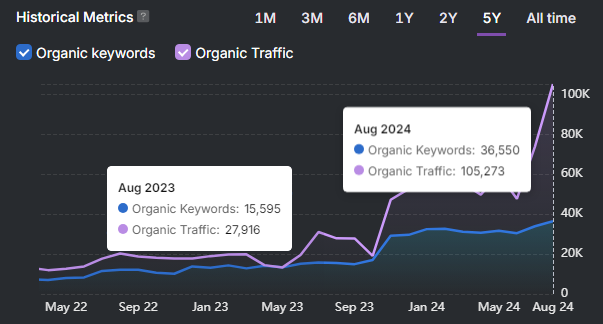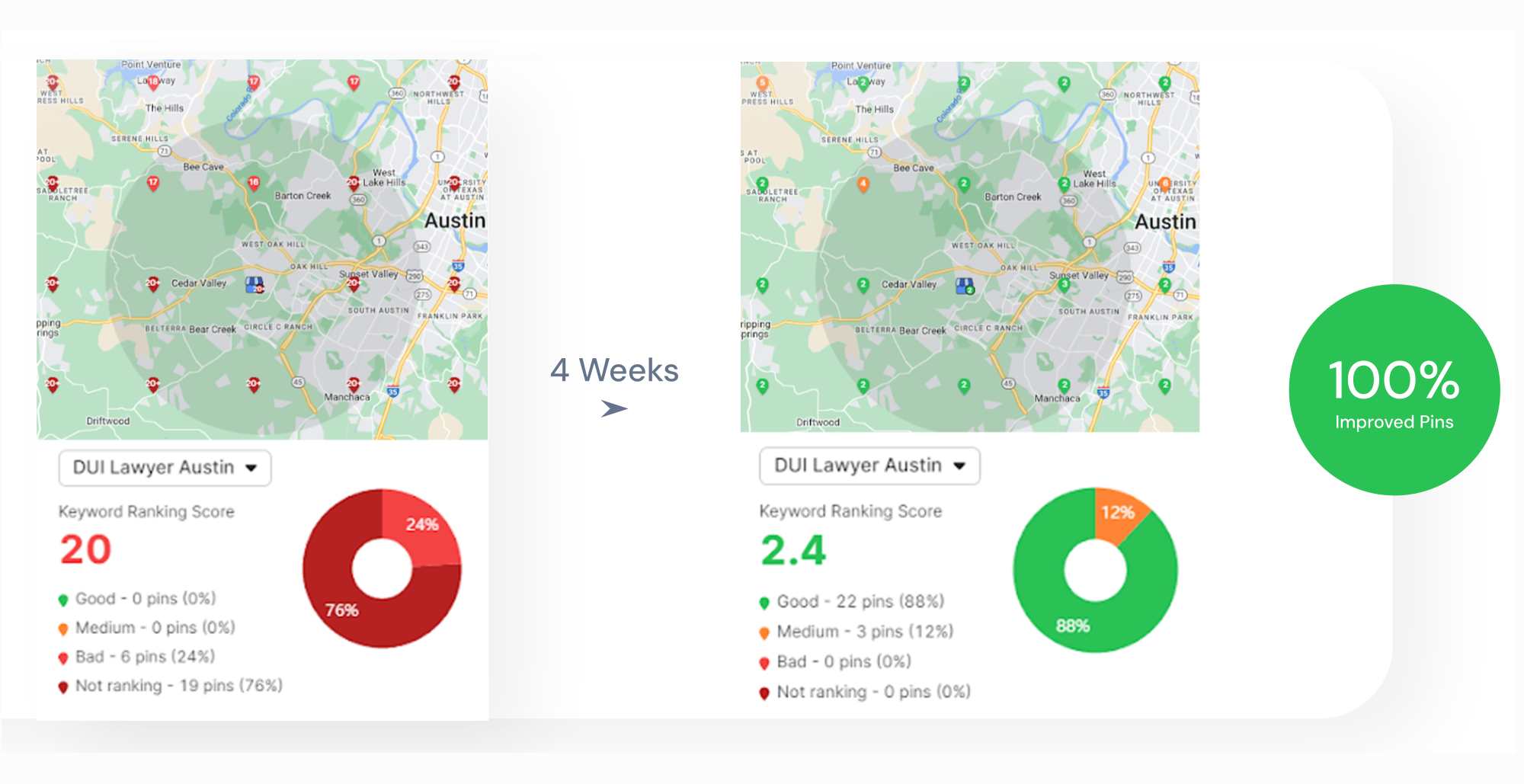Local search visibility has become a cornerstone of business growth, yet the true drivers behind Google Business Profile (GBP, formerly GMB) rankings are still debated. That’s the gap we set out to close.
We analyzed 3,269 local businesses across multiple sectors (food, health, and law), pairing GBP data, reviews, website content, and SERP grid performance to measure ranking outcomes.
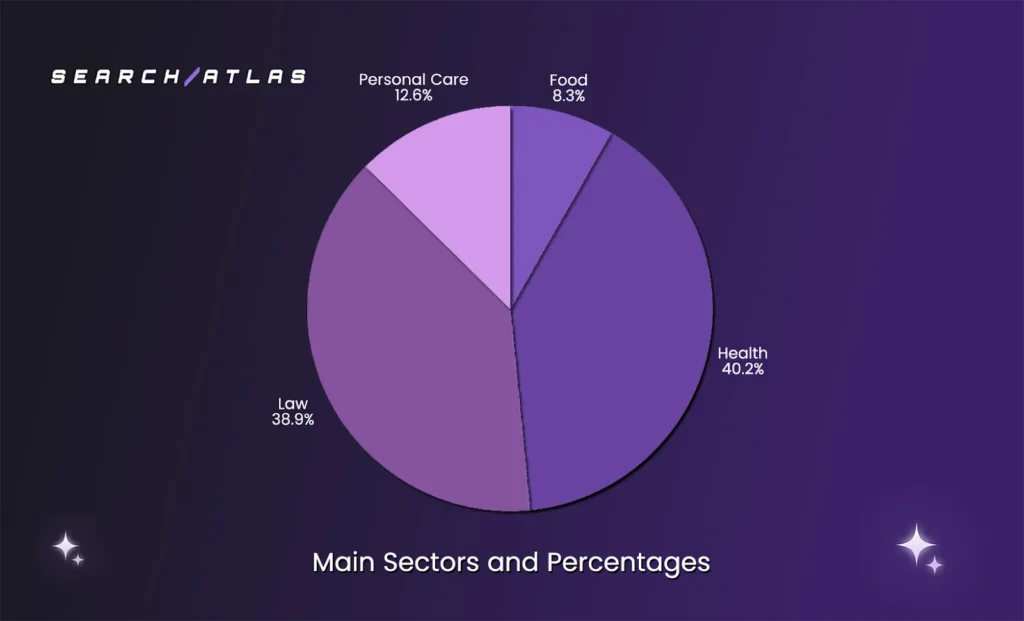
The study defines how GBP rankings shift based on proximity, reviews, and relevance. GBP ranking is the process by which Google orders businesses in the local map pack. GBP ranking matters because it drives customer discovery.
The study investigates proximity, reviews, and content relevance, which provides measurable percentages, sector-specific breakdowns, and practical recommendations. The study matters because local search influences user decisions directly.
What is the Final Takeaway?
The study done by Search Atlas in May 2025 and published in August 2025 proves proximity is the strongest universal driver, while reviews and relevance define competitive advantage. The study identifies proximity as baseline, reviews as differentiators, and relevance as sector-specific.
Businesses seeking local visibility must invest in reviews, keyword branding, and GBP completeness. Businesses must accept proximity as fixed. Businesses that adopt evidence-based, sector-specific strategies achieve higher ranking predictability.
Methodology
The study done by SA applies machine learning to analyze local ranking features. Machine learning (ML) refers to automated model training from data. Machine learning produces feature importance scores. Machine learning matters because it reveals hidden ranking correlations.
The researchers from SA use the Machine Learning technique called XGBoost regression. XGBoost is an ML algorithm and delivers scalable processing, robust feature weighting, and tabular data handling. XGBoost matters because it generates predictive accuracy for structured signals.
The dataset combines 3 key sources:
- Keyword-based SERP grid visibility.
- Business profile metadata.
- Website content and reviews.
The target variable is average position, the mean rank across grid queries that represents visibility distribution, positional accuracy, and rank prediction. The average position matters because it indicates exposure in local search.
What does the Global Analysis Show?
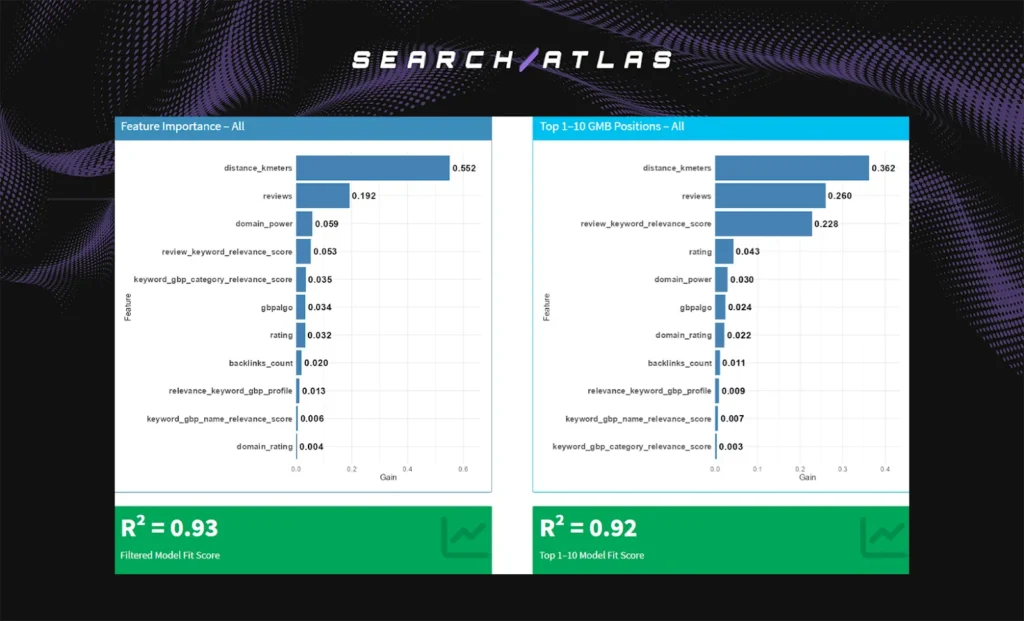
According to the global analysis conducted by Search Atlas, the model explains 92% to 93% of the variance in GBP rankings. The global model refers to the all-sectors dataset, which weights features across industries.
There are key factors that influence how high a business ranks in Google’s local search results. The key factors varied depending on the positions.
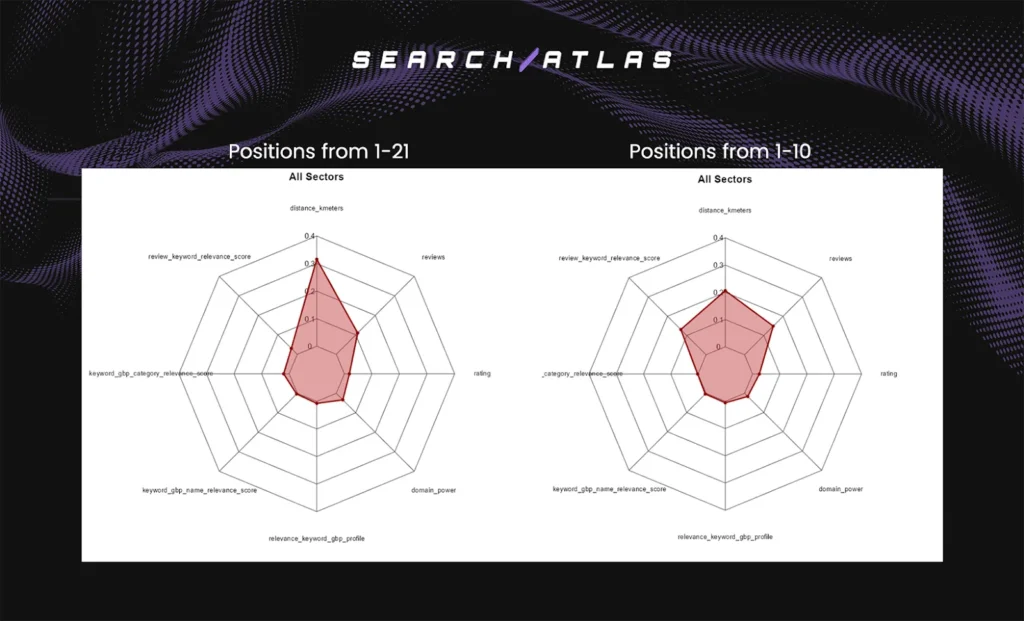
The key factors that influence businesses ranks in local search results for the positions from 1 to 21 are listed below.
- Proximity (55.2%): Distance to the grid centroid dominates, making location the strongest driver of visibility.
- Review Count (19.2%): The sheer volume of reviews strongly boosts rankings.
- Domain Power (5.9%): Website authority has moderate but noticeable impact.
- Semantic Relevance in Reviews (5.3%): Content alignment in customer reviews helps improve rank.
- Other Factors (<5%): Category relevance, ratings, GBP completeness, and backlinks add smaller but still meaningful contributions.
The key factors that influence businesses ranks in local search results for the positions from 1 to 10 are listed below.
- Proximity (36.2%): Still the leading factor, but less dominant at the very top.
- Review Count (26%): Plays a bigger role among leaders.
- Review Keyword Relevance (22.8%): Content alignment in reviews becomes crucial for breaking into the top 10.
- Supporting Features: Ratings, domain power, and GBP completeness continue to provide secondary lift.
Proximity, industry type, and review signals are the strongest drivers of Google local rankings, while profile details and ratings play only minor roles.
What are the Sector-Based Findings?
I, Manick Bhan, along with David Conde and Euthymios Kasvikis, ran experiments across major sectors to show which factors matter most for rankings in each industry. The breakdown to show which factors matter most for rankings in each industry is listed below.
Food Sector
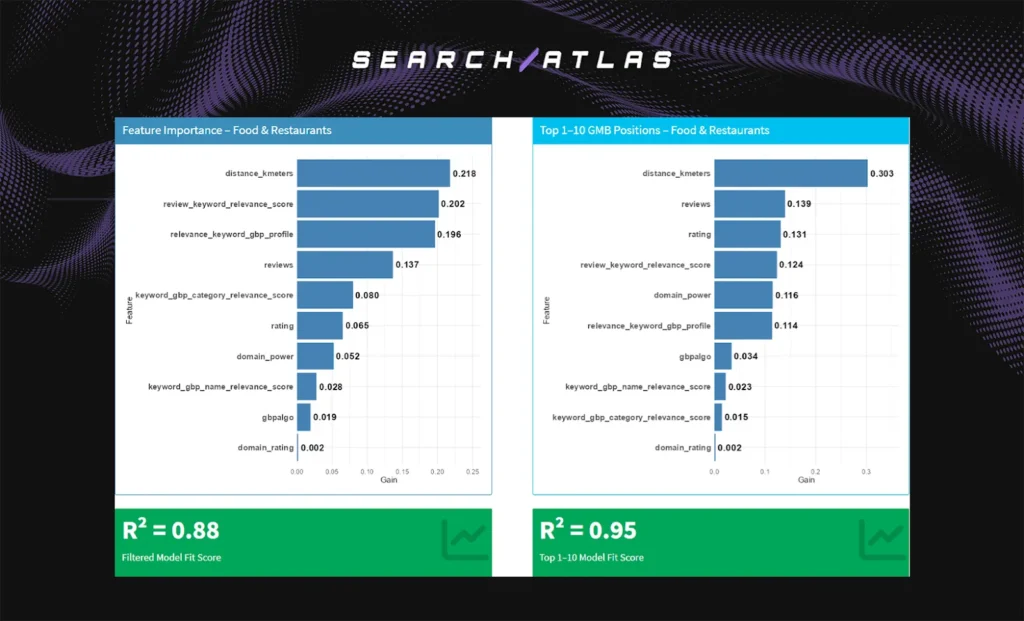
The Food sector shows review-driven differentiation beyond proximity. Food sector ranking refers to restaurant and dining-related businesses. Food sector ranking reflects competitive density. Food sector ranking matters because consumer decisions depend heavily on reviews.
The rankings for food businesses and the main factors influencing them are shown below.
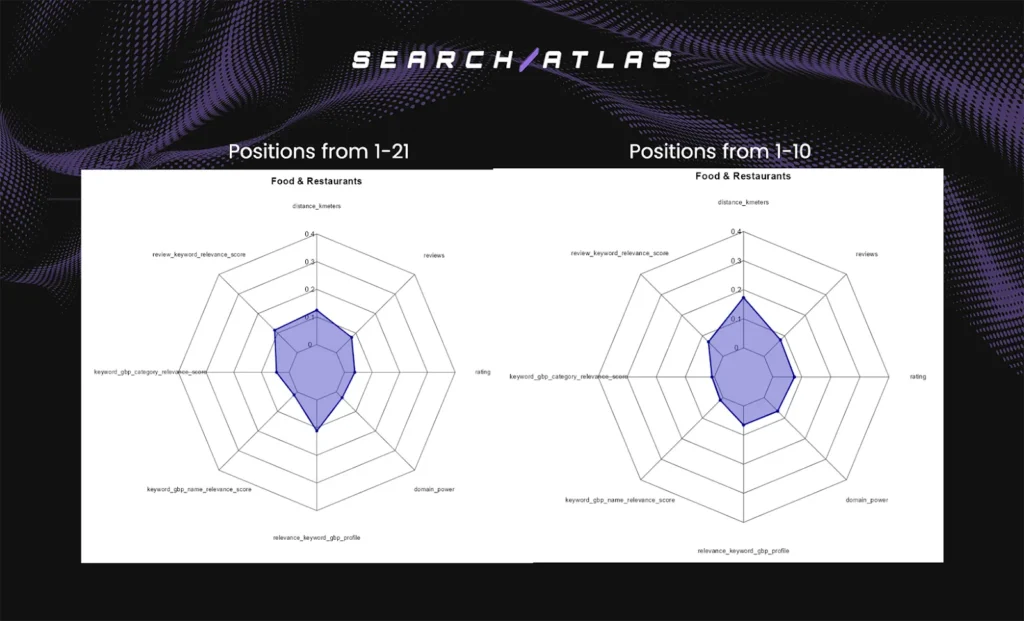
- Positions 1 to 21: The model explained 88% of the ranking differences. Distance is the top factor (22%), followed by review keyword relevance (20%) and profile relevance score (20%). Review count (14%) and category relevance (8%) provide additional weight, while rating (7%) and domain power (5%) play secondary roles.
- Positions 1 to 10: The model explained 95% of the ranking differences. Proximity grows in influence (30%), while reviews (count 14% and rating 13%) gain importance. Review keyword relevance (12%), domain power (12%), and profile relevance score (11%) contribute to top-tier placements.
Food businesses win visibility by combining strong local presence, semantically aligned reviews, profile completeness, and authoritative signals.
Health Sector
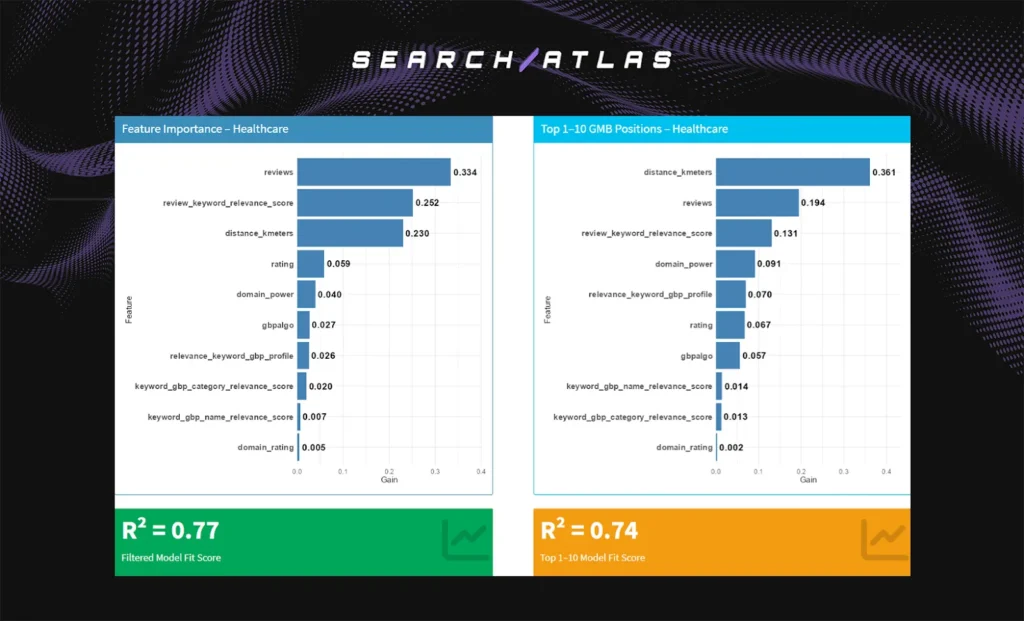
The Health sector combines proximity with review and category alignment. Health sector ranking refers to clinics, doctors, and medical services. Health sector ranking depends on trust and accuracy. Health sector ranking matters because patient selection relies on credibility.
The rankings for health businesses and the main factors influencing them are shown below.
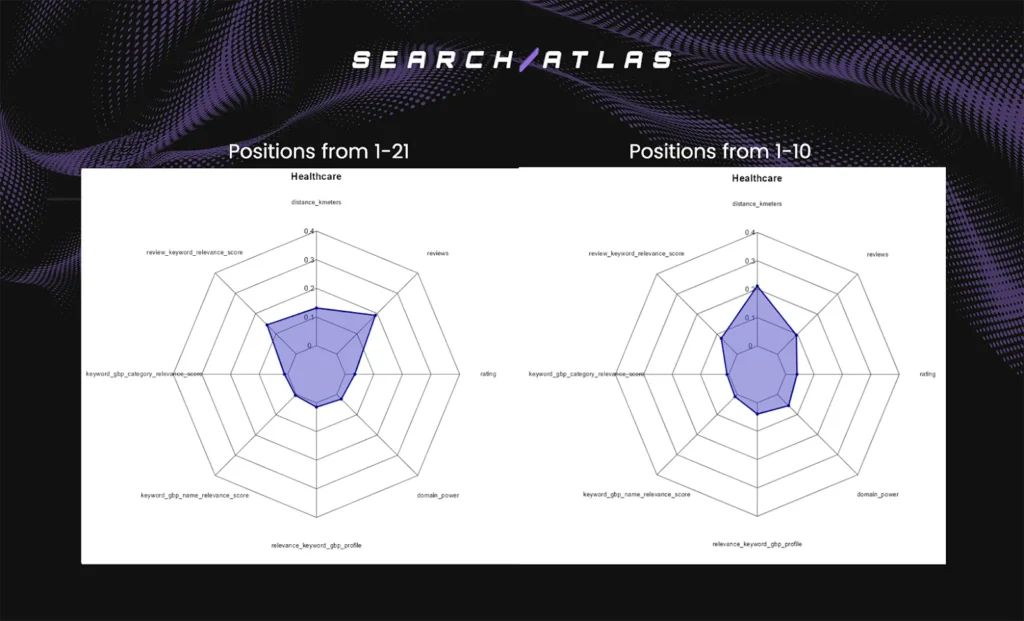
- Positions 1 to 21: The model explained 77% of the ranking differences. Reviews are the strongest factor (33.4%), followed by review keyword relevance (25.2%) and distance to centroid (23%). Ratings, domain power, GBP completeness, and profile content add smaller but meaningful contributions.
- Positions 1 to 10: The model explained 74% of the ranking differences. Distance becomes the top factor (36.1%), while reviews (19.4%) and review keyword relevance (13.1%) still play strong roles. Other signals such as domain power, rating, and profile content remain supportive but less critical.
Health businesses need a balance of location, review management, and keyword-rich content to secure top spots.
Law Sector
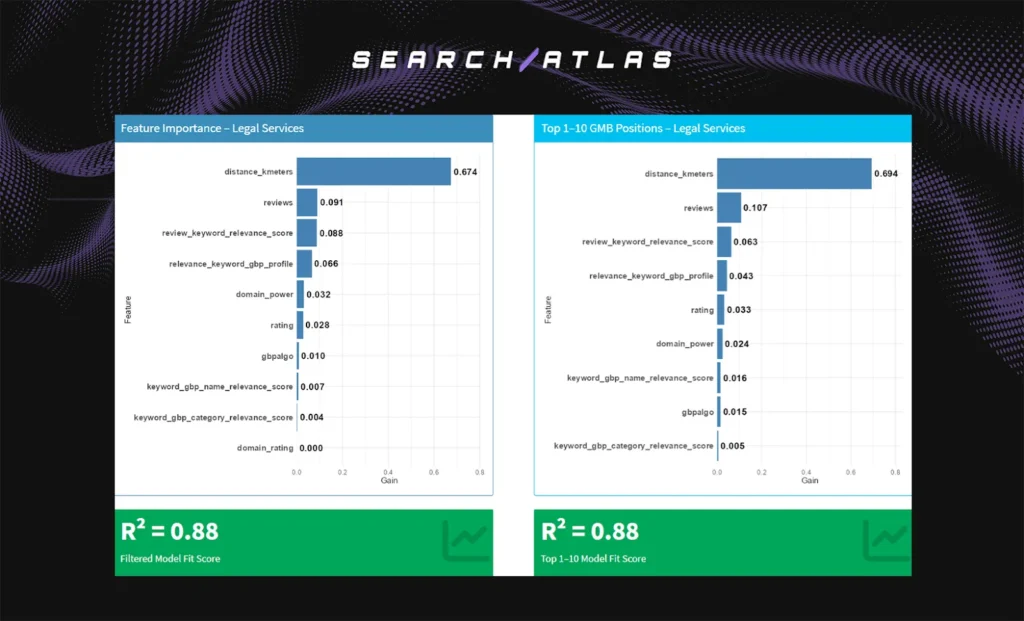
The Law sector highlights proximity as overwhelming. Law sector ranking refers to attorneys and legal services. Law sector ranking relies on trust, location, and visibility. Law sector ranking matters because clients seek nearby counsel.
The rankings for legal businesses and the main factors influencing them are shown below.
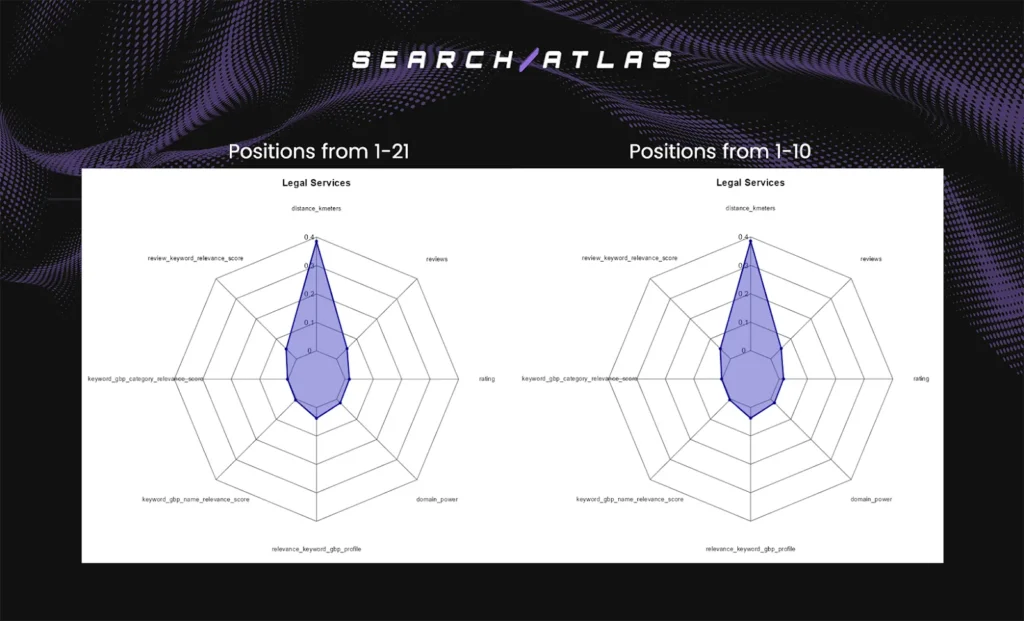
- Positions 1 to 21: The model explained 88% of the ranking differences. Proximity dominates with 67.4% influence. Reviews (9.1%) and review keyword relevance (8.8%) are secondary, while GBP profile relevance (6.6%) adds modest support. Other factors, including domain power, rating, and category relevance, each contribute less than 3%.
- Positions 1 to 10: The model explained 88% of the ranking differences. Distance grows even stronger at 69.4%. Reviews (10.7%) and review keyword relevance (6.3%) provide some influence, while GBP profile relevance (4.3%) and all other signals remain minimal.
Law firms succeed locally by being nearby and supported by credible, keyword-relevant reviews. Trust and locality outweigh technical SEO factors.
Beauty and Personal Care Sector
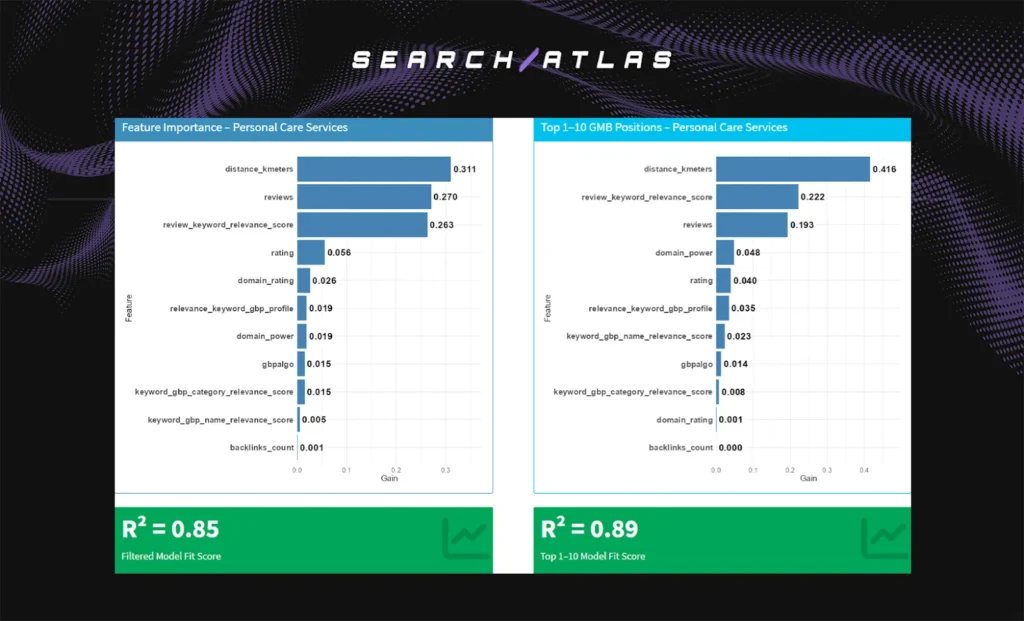
The Beauty sector relies most on reviews and branding. Beauty sector ranking refers to salons, spas, and personal care providers. Beauty sector ranking reflects aesthetics, branding, and customer trust. Beauty sector ranking matters because reputation drives customer acquisition.
The rankings for beauty and personal care businesses and the main factors influencing them are shown below.
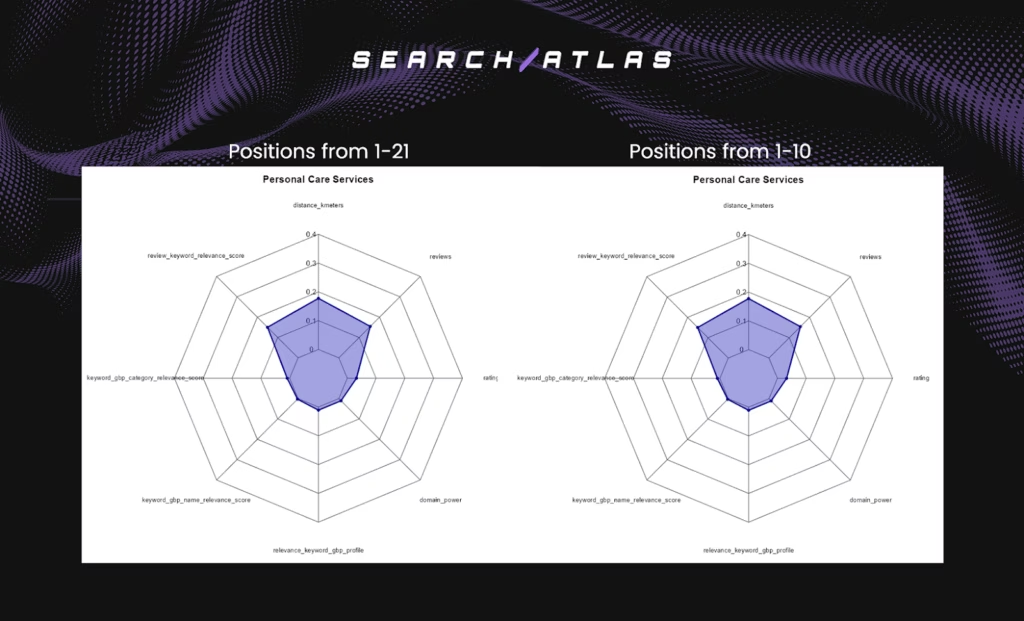
- Positions 1 to 21: The model explained 85% of the ranking differences. Proximity is the leading factor (31.1%), followed closely by review volume (27.0%) and review keyword relevance (26.3%). Other elements such as ratings, domain rating, and GBP relevance scores (name, category, profile) play smaller roles.
- Positions 1 to 10: The model explained 89% of the ranking differences. Proximity grows even stronger (41.6%), while review keyword relevance (22.2%) and review volume (19.3%) remain influential. Domain power, profile relevance, and keyword alignment add minor but measurable contributions.
In beauty and personal care, reputation and branding outweigh technical SEO factors. High review volume, semantically aligned review content, and strong local presence are decisive for top positions.
What Patterns Appear Across Sectors?
Proximity is the top driver of local visibility. Proximity means the distance between the searcher and the business centroid. Proximity accounted for 48% of predictive power in the global model covering positions 1 to 21. That figure nearly doubled the influence of business category, reviews, and authority signals.
Proximity does not always dominate in elite positions. In the top 1 to 10 rankings for food, beauty, and law, reviews, branding, and review keyword relevance gained more weight. In beauty, review volume and business name–keyword alignment together explained over 65% of predictive power, with proximity ranking secondary. In healthcare and personal care, semantic review alignment and domain authority contributed significantly to top placements.
What Should Local Businesses Do?
The implications for businesses are listed below.
1. Treat Proximity as a Baseline
Proximity influences inclusion in results. Businesses located closer to the grid centroid gain an advantage. Proximity cannot be adjusted. Treat proximity as a baseline factor, not a competitive differentiator.
2. Build a Review Strategy
Encourage reviews that include service-specific keywords. Analyze review text for semantic alignment with target queries. Prioritize quality, quantity, and context. Reviews that contain phrases such as “best dentist for whitening” outperform generic reviews such as “great service.”
3. Align Branding With Keyword Intent
Add keywords naturally to GBP names. A listing called Downtown Dental Clinic ranks higher for “dentist near me” compared to one called Smile Center. Branding with keyword intent creates alignment between business identity, search intent, and Google’s NLP-driven interpretation.
4. Optimize by Sector
Apply strategies that reflect sector weighting. Beauty benefits from review quantity and keyword branding. Law depends on proximity and review content. Health balances proximity, reviews, and category alignment. Sector-specific strategies outperform generic rules.
How Does This Compare to Industry Wisdom?
The study supports existing observations from the SEO community that proximity, reviews, and relevance shape rankings. The difference is quantification. The models assign measurable percentages to each factor.
The study extends beyond citations and NAP (Name, Address, Phone) consistency. It incorporates review text relevance, backlink anchor alignment, and URL content matching. These signals show that Google applies natural language processing (NLP) and entity recognition to extract meaning from reviews, website metadata, and backlink anchors.
What Could be the Limitations of the Study?
Every model has boundaries. The boundaries of the study are listed below.
- Proximity may be overweighted due to fixed grid data collection. Different radii or shapes may shift results.
- Correlation is not causation. The analysis measured associations, not direct algorithm rules.
- Sector imbalance may tilt global weights, since some industries contributed more data points.
Temporal factors matter. The snapshot captured rankings at one point in time, not across seasonal or algorithm shifts.








